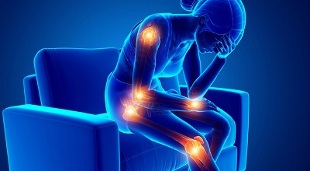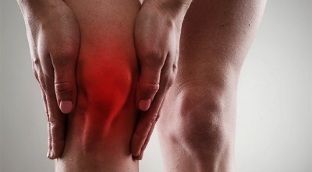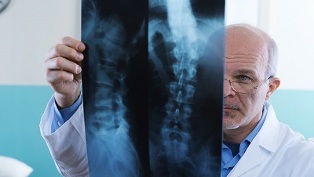Healthy joint tissue is made up of cells that can recover from damage - regrowth. Bones, cartilage, synovium and other elements can become unhealthy. Dead and damaged cells accumulate in certain tissues. They do not have the ability to split, which prevents re-growth. They are difficult to remove, which is a big problem in restoring joint health.
Under any physical activity, strong mechanical stress can damage the cell and result in its death. It is difficult for a sore joint to bear the burden. It is very difficult to recover. To prevent disease or overcome it, it is necessary to understand the mechanism of defense of tissue and articular cells. In the area of joint damage, arthritis, arthrosis, polyarthritis and other diseases are distinguished. Let us look in detail at the difference between arthritis and arthrosis.
The first cause of disease
The joints are protected by neuromuscular protections. Thanks to the muscle contraction control system, the shock effect does not occur or is reduced. The nervous system ensures smooth movement, load distribution. In calm conditions, the muscles also stimulate micro-vibrations, which leads to the release of lubricants, the removal of dead cells.
Impaired neuromuscular damping occurs due to poor nerve conduction flow. For example, fatigue weakens joint defenses. Dead cells begin to accumulate without being removed. The result is inflammation. The weakening of the defenses accelerates the deterioration of not only the joints, but also the spine.
A number of factors increase the risk of joint disease, ranging from stroke, bruising, overuse, hypothermia. Arthritis occurs - an inflammatory process. If it is impossible to cure it for months, the defect begins - arthrosis.
What is arthritis: causes, symptoms
The causes of its occurrence can be determined:
- Bad food.
- Bad habits: alcohol, smoking.
- Systematic hypothermia.
- Injuries.
- Excessive pressure on the joints.
- Due to illness, past infections.

This disease is detected by the following symptoms:
- Swelling in the joint area, painful sensations, increased sensitivity, limited movement (i. e. , synovitis).
- Sharp pain when moving and resting.
- Stiffness in the morning due to overnight swelling. An hour after the start, the activity passed.
In addition to the signs listed, symptoms of inflammation may appear: weakness, sweating, chills, fever. Some have headaches, weight loss. Sometimes the same disease occurs: the heart and lungs are affected.
What is arthrosis: causes and symptoms
As a result of progressive arthritis, symptoms of arthrosis in most cases appear only after 40 years.
This disease is characterized by the following manifestations:
- Pain does not appear in a calm state, but during exercise. Unpleasant sensations occur in the hip or knee joint while walking, using stairs, or exercising. This initial pain can go away with further movement. There is also a strong painful sensation, accompanied by pain, when bending, not bending.
- Pain when starting to move after rest appears as a result of deposition on the rubbing surface - a product of cartilage and bone destruction. The sensation may stop after 15 minutes as the sediment is removed.
- Boring pain at night appears due to venous congestion.
With arthrosis, inflammation often occurs. Along with the painful sensation, swelling is observed (as in arthritis). If there are symptoms of both diseases, arthrosis-arthritis is diagnosed.
Long-term arthritis can cause limited movement. In muscles, tendons, degenerative changes (contractures) begin, and then deform. In this case, the diagnosis is made - deformity of arthrosis or osteoarthritis.
Distinguish the degree of disease, determined by X-ray images, as a result of computed tomography:

- 1 degree- mild changes in cartilage, bone. Painful swelling occurs with moderate exercise, decreasing after a period of rest.
- 2 degrees- destruction of cartilage, growth of bone tissue at the edges in the form of osteophytes. Narrowing of joint space, accompanied by persistent pain. The swelling also becomes stable.
- 3, 4 degrees- extensive cartilage and bone destruction. Swelling does not go away, ligaments and muscles do not function properly, and deformation occurs. The axis of load is disturbed in the joint.
The risk factors that cause arthrosis are:
- Insufficient mobility.
- Overweight.
- Age factor.
- Infection is caused by inadequate blood and lymph flow, stagnation.
In all cases, the tissue does not have time to recover during the process of joint destruction.
The difference between arthritis and arthrosis
Both arthritis and arthrosis are becoming more common diseases. Diseases affecting the joints have a similar name. The difference lies in the nature of the negative changes that occur during the onset and development of symptoms. Pain in arthritis is the result of tissue inflammation. The synovium is affected, its blood supply, lymph is disrupted, the disease affects the nerve endings. The joints stop eating properly, and also fail to produce lubricants. Prone to suffering.
The disease can be seen not only in adults, but also in children (adolescent form). These lesions affect any joint, even small ones such as the fingers, and can even cover some of them (polyarthritis).
Arthrosis occurs as a result of chronic arthritis. Cartilage and the whole joint do not get nutrients from synovial fluid (lubricant) for a long time. Often there are exacerbations in the form of inflammation. First, the cartilage is destroyed, as is the bone covering, and at a later stage bone tissue may suffer. The cartilage area does not have time to grow back, it softens. Due to the violation of the sliding surface of the joint, pain appears.
This disease occurs after 40 years. Affects large joints (hip - coxarthrosis or knee - gonarthrosis), it can cause deformity, making a person disabled. Fingers (osteoarthritis) and feet are less common. And also this disease can be observed in the temporomandibular, elbows, shoulders and other joints.
Thus, arthrosis is the result of the development of arthritis symptoms, taking a destructive degree.
Prevention and Treatment

Lack of nutrition of cartilage and joints in arthritis should not be exacerbated by inflammation. Along with the reimbursement of anti-inflammatory drugs, the cause must be eliminated. If you do not take action, the disease can turn into arthrosis. If you suspect both of these diseases, you need to make a correct diagnosis, for which you need to see a specialist. This is done by rheumatologists, orthopedic traumatologists and surgeons. Must visit the clinic. And in some diagnostic centers, the patient is treated by an arthrologist.
An important healing principle is stopping destruction while stimulating recovery. This approach will help prevent irreversible changes. To do this, the tissue is cleaned of cells damaged by injury or infection. Improves blood and lymph flow, nutrition. Inadequate flow of nerve connections from the spine is often the cause of the development of arthritis and arthrosis. When signs of disease appear, it is necessary to reduce the load on the joints.
Drug therapy includes:
- Non-steroidal anti-inflammatory drugs, relieving pain.
- Hormone preparations in the form of injections.
- Cytostatics reduce the number of antibodies that kill cells.
- Cartilage and synovial fluid are restored with chondoprotectors.
Lymph flow, which cleans the affected cell tissue, is not stimulated. But there is a method of vibroacoustic therapy, which consists of micro vibration exposure from vibroacoustic therapy (from 30 to 20. 000 Hz). As well as physiotherapy, exercise is used. In stages 3 and 4 of this disease, they use prosthetics.
Conclusion
Painful sensations in the joint area and its functional dysfunction cause many serious problems. But the bigger problem is the inflammatory process that takes place in it, the destruction that restricts movement, causes deformation, deformity. It is important to identify the disease properly so that treatment can be carried out in a timely manner. Need to understand the causes of this problem, and also know the ways available to overcome it.























